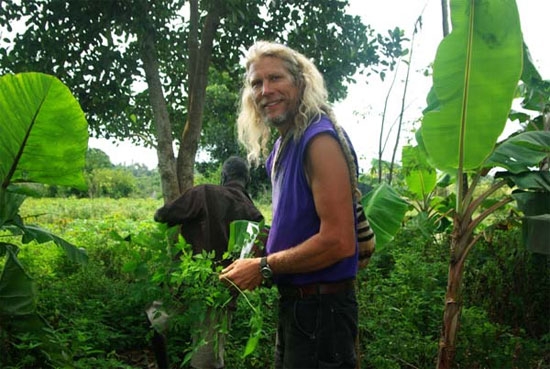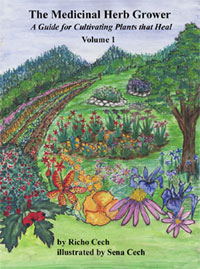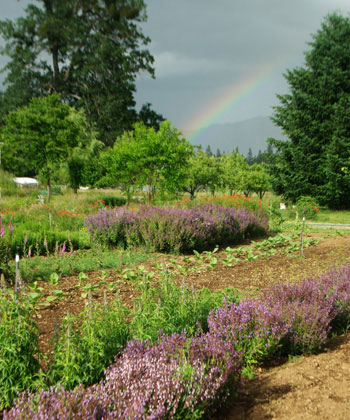
Above: Richo Cech in Zanzibar
Just as a horse whisperer understands the particular needs and psychology of horses, a plant whisperer is one who can receive the subtle communications from plants revealing their special needs for successful cultivation.
In both instances, only someone with a unique aptitude who is willing to invest years of patient observation and trial and error may attain such a gift. I would certainly designate Richo Cech, herbalist, horticulturist, world traveler, archaeologist, linguist, author, founder and owner of Horizon Herbs, as just such a ‘plant whisperer.’ He has patiently mastered the secrets of cultivating wild medicinal herbs, some of which have never been successfully cultivated before, such as Osha (Ligusticum porteri) and Mandrake (Mandragora species) to name only two.
Simply put, Richo is an herbalist who knows plants from the ground up ‘” and that is very rare.
Richo recently spoke at our annual East West Herb School Spring seminar. Students had an opportunity on two occasions to appreciate Richo’s profound wisdom and understanding regarding the cultivation of wild medicinal herbs. His second presentation focused on his recent trip to Zanzibar where his ability to speak Swahili allowed him to converse with natives of the region.
Richo works with an incredibly diverse range of medicinal, edible, rare, and all organic plants at his farm located in a small temperate region of Southern Oregon where he lives with his family and associates. Horizon Herb Farm has grown to become the country’s leading source for hard-to-find medicinal herbs. He is occasionally smitten with the passion of wanderlust that, besides seasonal appearances at various herb conferences around the country, includes forays into exotic distant lands in search of medicinal plants and the people of those regions who know how to use them.
 As a master herb gardener, Richo knows the optimal placing, sun exposure, watering, soil conditions and other requirements that go into successfully cultivating plants, especially non-cultivar species of wild medicinal herbs. Many of us whose focus has been in other areas of involvement with herbs such as education, clinical practice, research and product development, have only limited time for such gardening ventures. The result is that each year we expend considerable time and money to purchase and attempt to grow the same plants or seeds that we were unsuccessful cultivating in previous years. Fortunately, Richo’s new book,The Medicinal Herb Grower: A Guide for Cultivating Plants that Heal (Volume 1), is the next best thing to having a master gardener like Richo by your side.
As a master herb gardener, Richo knows the optimal placing, sun exposure, watering, soil conditions and other requirements that go into successfully cultivating plants, especially non-cultivar species of wild medicinal herbs. Many of us whose focus has been in other areas of involvement with herbs such as education, clinical practice, research and product development, have only limited time for such gardening ventures. The result is that each year we expend considerable time and money to purchase and attempt to grow the same plants or seeds that we were unsuccessful cultivating in previous years. Fortunately, Richo’s new book,The Medicinal Herb Grower: A Guide for Cultivating Plants that Heal (Volume 1), is the next best thing to having a master gardener like Richo by your side.
What sets medicinal plants apart from the rest
In The Medicinal Herb Grower, Richo describes how food crops called cultivars are loaded with nutritious and tasty primary compounds, such as starch, sugar and proteins. But in the case of medicinal herbs, their desired properties mostly come from secondary compounds consisting of aromatic, acrid, bitter or even toxic compounds such as alkaloids, terpenoids, saponins and glycosides in relatively low concentration. These secondary compounds arise as part of the process of “attracting pollinators, repelling browsers, defending themselves, or communicating with other plants, insects, and vertebrates – including humans.”
What distinguishes plants used for food from those used for medicine is food plants’ comparative lack of secondary compounds as compared to medicinal herbs. It is these secondary compounds evolving out of the stress and struggle for a plant’s existence that make them useful for treating imbalances and diseases within our own psycho-physiological systems.
Richo declares himself “leery of hybridization, tissue culture, and genetic modification of medicinal plants” because they alter the concentration of naturally evolved secondary plant compounds. He asserts that these practices render an herb “less predictable and less dependable for medicinal use” and consequently diminish our ability to rely on traditional wisdom to inform us of its use.
Personally, I don’t think this is a sufficient reason to not avail ourselves of the ability to alter plants to suit our perceived needs. In fact, through selective cultivation, hybridization and other methods, people have always altered plants to suit their needs. Even Richo points out how certain strains of medicinal plants such as German chamomile, garden sage and valerian have been selected for higher levels of those secondary compounds associated with medicinal properties. Just as the greatest horticultural advance in history has been the cultivation of cannabis over the last 40 years, from a weed during the late 1960s to a plant today that literally reeks of mind-altering tetrahydrocannabinol (THC), similarly there is a long history of intentional cultivation to produce the most effective medicinal plants.
Working with nature
Richo’s book reminds us of how to work with, rather than against, nature; and it reminds us that this practice is best both for medicinal plant cultivation as well as a strategy for healing. Both healer and plant whisperer must first acknowledge the need inherent in any cultivation or healing problem. It is out of that need, based on passive observation, that one can plot a strategy to work with the life force. It is always a task best done with humility and respect, and as such may require a considerable amount of patience.
Two stories from The Medicinal Herb Grower illustrate the patience it takes to make a plant thrive. One is the author’s attempt to cultivate eleuthero (Eleutherococcus senticosus), considered an adaptogen tonic in the ginseng family. Richo describes how, after getting off to a good start in his open garden area, by midsummer in hot and dry southern Oregon “the leaves crisped on the plant like bread left too long in the toaster.” He considered how the plant grows in Siberia, “flourishing in thick stands around the margins of cold lakes.” So in the Fall he decided to transplant the suffering plants into a tree-shaded area near the creek. In subsequent years “the ants danced on the eleuthero flowers, and the branches grew heavy with fruit.” From this he learned how the placement of plants can be critical to successfully growing them.
Another story relates how he was able to fulfill a perhaps ancestral yearning to grow mandrake. This rare plant of European origin has a long history dating back to biblical times for use in magic and medicine. It is considered rare and difficult to grow. At first, Richo planted the seeds in gallon containers and set them in the best spot in his shadehouse. Each year the sprouts would appear in the early spring and mysteriously die back in a couple of months. By the third year this was still happening! He asked a friend who had lived in the Middle East about their native habitat, who said they grew “out in the open, among the rocks, in alkaline soil,” without much rain. Richo placed his seeds accordingly, and now is the proud steward of thriving five year-old mandrakes.
 The Medicinal Herb Grower: Practical and a pleasure to read
The Medicinal Herb Grower: Practical and a pleasure to read
The Medicinal Herb Grower is no dry manual; Richo’s prosaic flair makes reading the book a delight. In a section entitled ‘A Tour of the Horizon Herbs Seed Farm,’ he writes, “The creek flows through the year, in the summer slurring over slimy boulders, in the winter chattering whitewater, boulders scrubbed clean, periwinkles holding on beneath for dear life. There’s a secret western garden under the shade of a maple that reaches her arms up from the yin-soaked streamside to clasp to her breast, like a yearning mother, a shade garden of her own making.”
From a practical standpoint, I particularly loved Chapter 5, ‘Rules of Green Thumb.’ I think if someone who sincerely believes that they don’t have the ability to grow things reads and follows all or some of the 17 suggestions (by my count) of this chapter they can’t fail.
There is something so universal about this book that it is destined to become a real classic for anyone interested in cultivating medicinal herbs. It offers everything one needs to grow a successful garden, whether it be of flowers, vegetables, fruit trees, medicinal herbs, or a mixture of all of the above. Richo flat out states that the best protection against pests is diversity.
The Medicinal Herb Grower is chock full of practical information about every aspect of gardening, from seed preparation, to building a green house or a shade house, to various methods for making compost, to proper plant positioning, watering and drainage, along with more advanced methods for growing. All of it is drawn from the author’s personal experience which, in my opinion, is the secret of a good book. It’s hard to believe that so much practical information can be presented in such a short space and still have room for the author to express his poetic and philosophical life views and even tell stories of his working as an archaeologist where he explored the early roots of gardening at the Koster site in southern Illinois which dates back to 7500 B.C.E.
Richo’s book has been celebrated and recognized by other prominent herbalists and horticulturists. Jim Duke, PhD, herbalist, botanist, formerly with the Department of Agriculture, and author of 20 books on herbal medicine, says The Medicinal Herb Grower is “a very different book, no bibliographic echoes, all good gardening and nature first hand. This book is a pleasure to read, and a treasure of valuable cultural information.”
Christopher Hobbs, renowned herbalist and botanist, himself an author of dozens of books and articles on herbs, describes Richo’s book as “the most definitive herb grower’s guide on the planet, a book that breathes with aliveness, humor, and how to really do it!”
I recall my first childhood attempts at gardening on small a plot my mother gave me to ‘grow things.’ Each day I would lovingly return to my small plot and fuss with the plants, instinctively digging and loosening the soil around their bases (a technique called ‘Rubber Fingers’ by Richo in Chapter 13, which goes to show that if we want to acquire a green thumb, we must first be willing to have dirty thumbs!). I seem to remember how wonderfully everything grew without the addition of soil nutrients.
I’ve been gardening ever since that boyhood plot and couldn’t stop even if I wanted to. Through The Medicinal Herb Grower and his visit to my home and as a guest teacher to our seminar I personally find Richo to be rich source of useful information and inspiration that has made a positive difference in my gardening this year.
